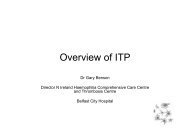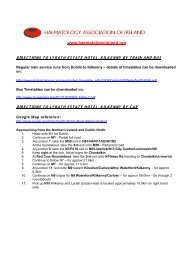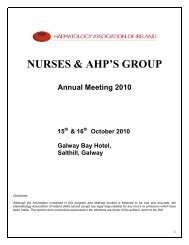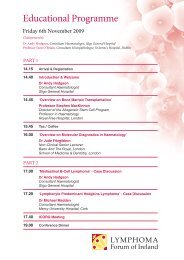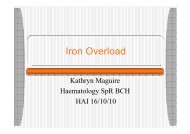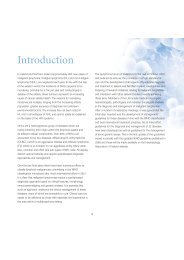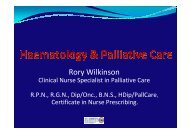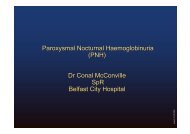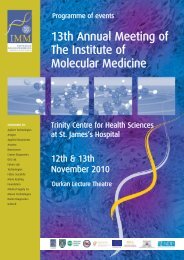Guidelines on Diagnosis and Treatment of Malignant Lymphomas
Guidelines on Diagnosis and Treatment of Malignant Lymphomas
Guidelines on Diagnosis and Treatment of Malignant Lymphomas
Create successful ePaper yourself
Turn your PDF publications into a flip-book with our unique Google optimized e-Paper software.
Prognostic Factors / Index:<br />
i. Early stage disease (I – IIA)<br />
ii.<br />
Adverse factors:<br />
Advanced stage disease (IIB – IV)<br />
Adverse factors:<br />
(Internati<strong>on</strong>al<br />
Prognostic score)<br />
Age > 50 years<br />
ESR > 50 mm /hr or > 30 mm /hr<br />
with B symptoms<br />
Four or more separate nodal<br />
sites involved<br />
Mediastinial mass ratio > 1/3<br />
Age > 45 years<br />
Male sex<br />
Stage IV<br />
Haemoglobin < 10.5 g/dl<br />
Albumin < 40 g/l<br />
Lymphocytes < 0.6 x 10 9 /l or < 8%<br />
White blood count > 15 x 10 9 /l<br />
Potential Pitfalls<br />
i. Failure to differentiate between NLPHL <strong>and</strong> CHL<br />
ii. C<strong>on</strong>fusi<strong>on</strong> with DLBCL <strong>and</strong> its variants<br />
iii. Incorrect stage<br />
<strong>Treatment</strong> <strong>of</strong> nodular lymphocyte<br />
predominant HL<br />
The treatment <strong>of</strong> NLPHL is undergoing review. Where there is<br />
stage I disease <strong>and</strong> no B symptoms or adverse clinical risk<br />
factors, the patient may be treated with involved field radiati<strong>on</strong><br />
therapy (IFRT) 30Gy or may be observed following nodal excisi<strong>on</strong><br />
in the absence <strong>of</strong> residual disease. Rituximab may be used as an<br />
alternative or in additi<strong>on</strong> to radiotherapy. Patients with extensive<br />
or relapsed disease can be treated with Rituximab c<strong>on</strong>taining<br />
CHOP or ABVD.<br />
<strong>Treatment</strong> <strong>of</strong> classical HL<br />
Early stage disease<br />
Clinical stage IA or IIA<br />
<strong>Treatment</strong>:<br />
ABVD x 4 cycles <strong>and</strong> involved field radiati<strong>on</strong><br />
therapy (IFRT) 20-30Gy<br />
Or<br />
ABVD x 6 cycles<br />
The use <strong>of</strong> radiotherapy in stage I <strong>and</strong> II disease is associated<br />
with a lower risk <strong>of</strong> relapse, <strong>and</strong> this has to be <strong>of</strong>f set by<br />
c<strong>on</strong>cerns about l<strong>on</strong>g term morbidity following radiotherapy.<br />
Advanced Stage Disease<br />
Clinical stages IIB to IV<br />
St<strong>and</strong>ard treatment is with ABVD x6-8 cycles or escalated<br />
BEACOPP. A rati<strong>on</strong>al approach using the known prognostic value<br />
<strong>of</strong> PET scanning after 2 courses <strong>of</strong> ABVD may be to intensify<br />
treatment to escalated or dose-dense BEACOPP if the PET scan is<br />
deemed positive at this stage. This approach is currently being<br />
tested in the RATHL study sp<strong>on</strong>sored by the British NCRN group.<br />
Little c<strong>on</strong>sensus exists <strong>on</strong> the role <strong>of</strong> radiati<strong>on</strong> in advanced<br />
stage disease. Ideally all patients should be reviewed in an<br />
MDT setting at the beginning <strong>and</strong> end <strong>of</strong> therapy to review the<br />
indicati<strong>on</strong> for radiotherapy<br />
Resp<strong>on</strong>se Evaluati<strong>on</strong><br />
Patients should have careful clinical evaluati<strong>on</strong> with each cycle <strong>of</strong><br />
chemotherapy <strong>and</strong> treatment delays should be avoided. ABVD<br />
can be safely administered <strong>on</strong> schedule in the presence <strong>of</strong><br />
moderate neutropenia without GCSF support<br />
Resp<strong>on</strong>se evaluati<strong>on</strong> with repeat radiology <strong>of</strong> abnormal sites at<br />
presentati<strong>on</strong> is traditi<strong>on</strong>ally undertaken after four cycles <strong>of</strong> therapy,<br />
however if F18DG-PET/CT scanning is used this evaluati<strong>on</strong> is most<br />
usefully carried out after two courses <strong>of</strong> chemotherapy<br />
61



